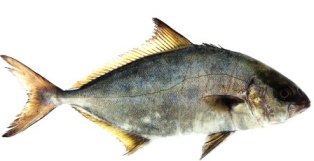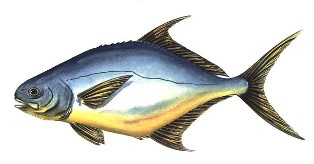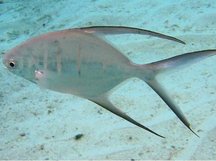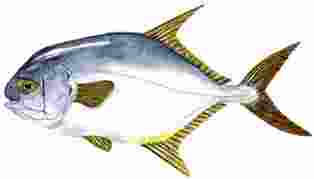Discover Florida Nature
It's time to explore the natural Florida


|
|
|
|
|
 Greater
Amberjack
(Seriola dumerili) In the western Atlantic Ocean, the
greater amberjack is found off Nova Scotia, Canada south to Brazil
including Bermuda, the Gulf of Mexico, and the Caribbean Sea. A
subtropical species, the greater amberjack is often associated with
rocky reefs, floating debris, and wrecks at depths ranging from 60-240
feet. It has also been reported at inshore locations off the coast of
Florida. Studies have shown that some greater amberjack populations are
full time residents along the gulf and Atlantic coasts of Florida while
other populations migrate from the South Atlantic Bight into inshore
waters during certain times of the year. Greater amberjack congregate in
schools when they are young, however this schooling behavior decreases
as the fish grows older. The oldest fish are primarily solitary. The
greater amberjack is slender, fusiform jack with a short and pointed
head and relatively small eyes. The terminally located mouth is large
with a posteriorly broad maxilla reaching the middle of the eye. The
pectoral fins are shorter than the head, and approximately equal in
length to the pelvic fins. The second dorsal fin is much longer than the
anal fin and the caudal peduncle is deep with grooves above and below
the base of the caudal fin. The greater amberjack, largest of the jacks,
has a brownish or bluish grey dorsal side (above the lateral line) and a
silvery white ventral side. There is a dark amber stripe running from
the nose to just in front of the dorsal fin. Great amberjacks grow to a
maximum total length of 6.2 feet (1.9 m). Although the maximum published
weight of this species is 80.6 kg, these fish typically reach about 39.7
pounds (18 kg) in weight. Females grow larger in size and live longer
than males. Maximum life span is believed to be at least 17 years. As
opportunistic predators, greater amberjacks feed on benthic and pelagic
fishes as well as squid and crustaceans. Greater
Amberjack
(Seriola dumerili) In the western Atlantic Ocean, the
greater amberjack is found off Nova Scotia, Canada south to Brazil
including Bermuda, the Gulf of Mexico, and the Caribbean Sea. A
subtropical species, the greater amberjack is often associated with
rocky reefs, floating debris, and wrecks at depths ranging from 60-240
feet. It has also been reported at inshore locations off the coast of
Florida. Studies have shown that some greater amberjack populations are
full time residents along the gulf and Atlantic coasts of Florida while
other populations migrate from the South Atlantic Bight into inshore
waters during certain times of the year. Greater amberjack congregate in
schools when they are young, however this schooling behavior decreases
as the fish grows older. The oldest fish are primarily solitary. The
greater amberjack is slender, fusiform jack with a short and pointed
head and relatively small eyes. The terminally located mouth is large
with a posteriorly broad maxilla reaching the middle of the eye. The
pectoral fins are shorter than the head, and approximately equal in
length to the pelvic fins. The second dorsal fin is much longer than the
anal fin and the caudal peduncle is deep with grooves above and below
the base of the caudal fin. The greater amberjack, largest of the jacks,
has a brownish or bluish grey dorsal side (above the lateral line) and a
silvery white ventral side. There is a dark amber stripe running from
the nose to just in front of the dorsal fin. Great amberjacks grow to a
maximum total length of 6.2 feet (1.9 m). Although the maximum published
weight of this species is 80.6 kg, these fish typically reach about 39.7
pounds (18 kg) in weight. Females grow larger in size and live longer
than males. Maximum life span is believed to be at least 17 years. As
opportunistic predators, greater amberjacks feed on benthic and pelagic
fishes as well as squid and crustaceans. Lesser
Amberjack
(Seriola fasciata) This small jack is difficult to
separate from the greater amberjack, but it does have a deeper body for
its length than the greater amberjack. The diagonal dark bar through the
eye may stop short of the dorsal fin. It extends to the dorsal fin in
the greater amberjack. The lesser amberjack occurs in the Eastern and
Western Atlantic Oceans. In the Atlantic, it is found from Massachusetts
to Brazil. Lesser amberjacks off the Louisiana coast are more abundant
than in other Gulf coast waters, possibly due to the fact that they
don't have as much fishing pressure here as in other places that have
commercialized them. Another drawing factor might be the structural
habitat that the many oil platforms provide for the species Lesser
amberjacks don't usually venture into water less than 100 feet in depth
and the largest ones stay exclusively in deeper water, sometimes over
600 feet. The maximum reported size is 27 inches in Florida. The lesser
amberjack feeds on squids and fishes. Lesser
Amberjack
(Seriola fasciata) This small jack is difficult to
separate from the greater amberjack, but it does have a deeper body for
its length than the greater amberjack. The diagonal dark bar through the
eye may stop short of the dorsal fin. It extends to the dorsal fin in
the greater amberjack. The lesser amberjack occurs in the Eastern and
Western Atlantic Oceans. In the Atlantic, it is found from Massachusetts
to Brazil. Lesser amberjacks off the Louisiana coast are more abundant
than in other Gulf coast waters, possibly due to the fact that they
don't have as much fishing pressure here as in other places that have
commercialized them. Another drawing factor might be the structural
habitat that the many oil platforms provide for the species Lesser
amberjacks don't usually venture into water less than 100 feet in depth
and the largest ones stay exclusively in deeper water, sometimes over
600 feet. The maximum reported size is 27 inches in Florida. The lesser
amberjack feeds on squids and fishes.  Florida
Pompano (Trachinotus carolinus) Pompano are
deep-bodied fish, grayish, blue on the back shading to silver on the
side with yellow beneath. There is a bluish tint above and in front of
the eyes. The side of the tail and caudal peduncle is smooth in contrast
to the similar-looking jack crevalle. The
average size is two to five pounds. Pompano range from inshore waters to
offshore throughout the Gulf of Mexico. Pompano are common along Gulf
beaches and passes where they feed on beach fleas, shrimp, small fish
and animals buried in the sand. In September and October, adults move
into the bays. These deep-bodied fish flash their silver sides and
yellow bodies when they jump in the wake of boats in the coastal bays.
Many consider the pompano to be the most delicious of all Gulf fish,
particularly broiled with butter. Florida
Pompano (Trachinotus carolinus) Pompano are
deep-bodied fish, grayish, blue on the back shading to silver on the
side with yellow beneath. There is a bluish tint above and in front of
the eyes. The side of the tail and caudal peduncle is smooth in contrast
to the similar-looking jack crevalle. The
average size is two to five pounds. Pompano range from inshore waters to
offshore throughout the Gulf of Mexico. Pompano are common along Gulf
beaches and passes where they feed on beach fleas, shrimp, small fish
and animals buried in the sand. In September and October, adults move
into the bays. These deep-bodied fish flash their silver sides and
yellow bodies when they jump in the wake of boats in the coastal bays.
Many consider the pompano to be the most delicious of all Gulf fish,
particularly broiled with butter. Palometa
(Caranx hippos) The palometa fish is most common in south
Florida. This fish can be found in clear water along sandy beaches and
bays, and is occasionally found over reefs. The palometa is
grayish-blue-green on top of it's head and along the back, with bright
silvery sides and yellow on it's breast. The palometa is rarely over 1
pound, but has been reported as large as three pounds. This fish is
thought to spawn offshore in spring, summer, and fall. The palometa
readily strikes small artificial lures. Palometa
(Caranx hippos) The palometa fish is most common in south
Florida. This fish can be found in clear water along sandy beaches and
bays, and is occasionally found over reefs. The palometa is
grayish-blue-green on top of it's head and along the back, with bright
silvery sides and yellow on it's breast. The palometa is rarely over 1
pound, but has been reported as large as three pounds. This fish is
thought to spawn offshore in spring, summer, and fall. The palometa
readily strikes small artificial lures. Permit
(Trachinotus falcatus) Permit inhabit the western
Atlantic from Massachusetts to southeastern Brazil. They occur
throughout the West Indies and the Gulf of Mexico, and less-frequently
in Bermuda. The species has been reported in the eastern Atlantic, but
does not regularly occur there. The species is most abundant in southern
Florida. Permit primarily occupy inshore regions such as flats and sandy
beaches, and deeper cuts, channels, and holes adjacent to these areas.
The substrate of the flats may vary from sand, mud, marl, or sea grass.
Permit often swim in water depths less than 2 feet. The deeply forked
tail and elongated anterior dorsal fin provide the more distinct
characteristics of the permit. Looking like long sickles, these fins
impart the fish's species name falcatus. However, one can also identify
the permit by its highly laterally compressed body, making the fish
appear thin and tall. Permit have bright silver sides and bluish-green
or brown backs. Like the
bonefish, the permit uses its hard mouth to dig into the benthos and
root up its prey. These food items usually consist of crustaceans and
mollusks, which the permit crushes with its granular teeth and
pharyngeal bony plates. However, as opportunistic feeders, permit will
eat a variety of animals, including amphipods, copepods, mollusks,
polychaetes, fish and insects. Permit
(Trachinotus falcatus) Permit inhabit the western
Atlantic from Massachusetts to southeastern Brazil. They occur
throughout the West Indies and the Gulf of Mexico, and less-frequently
in Bermuda. The species has been reported in the eastern Atlantic, but
does not regularly occur there. The species is most abundant in southern
Florida. Permit primarily occupy inshore regions such as flats and sandy
beaches, and deeper cuts, channels, and holes adjacent to these areas.
The substrate of the flats may vary from sand, mud, marl, or sea grass.
Permit often swim in water depths less than 2 feet. The deeply forked
tail and elongated anterior dorsal fin provide the more distinct
characteristics of the permit. Looking like long sickles, these fins
impart the fish's species name falcatus. However, one can also identify
the permit by its highly laterally compressed body, making the fish
appear thin and tall. Permit have bright silver sides and bluish-green
or brown backs. Like the
bonefish, the permit uses its hard mouth to dig into the benthos and
root up its prey. These food items usually consist of crustaceans and
mollusks, which the permit crushes with its granular teeth and
pharyngeal bony plates. However, as opportunistic feeders, permit will
eat a variety of animals, including amphipods, copepods, mollusks,
polychaetes, fish and insects.
|
|
|
Advertise | Privacy Statement | Dog Encyclopedia | Video |Contact | Alaska Nature |
|